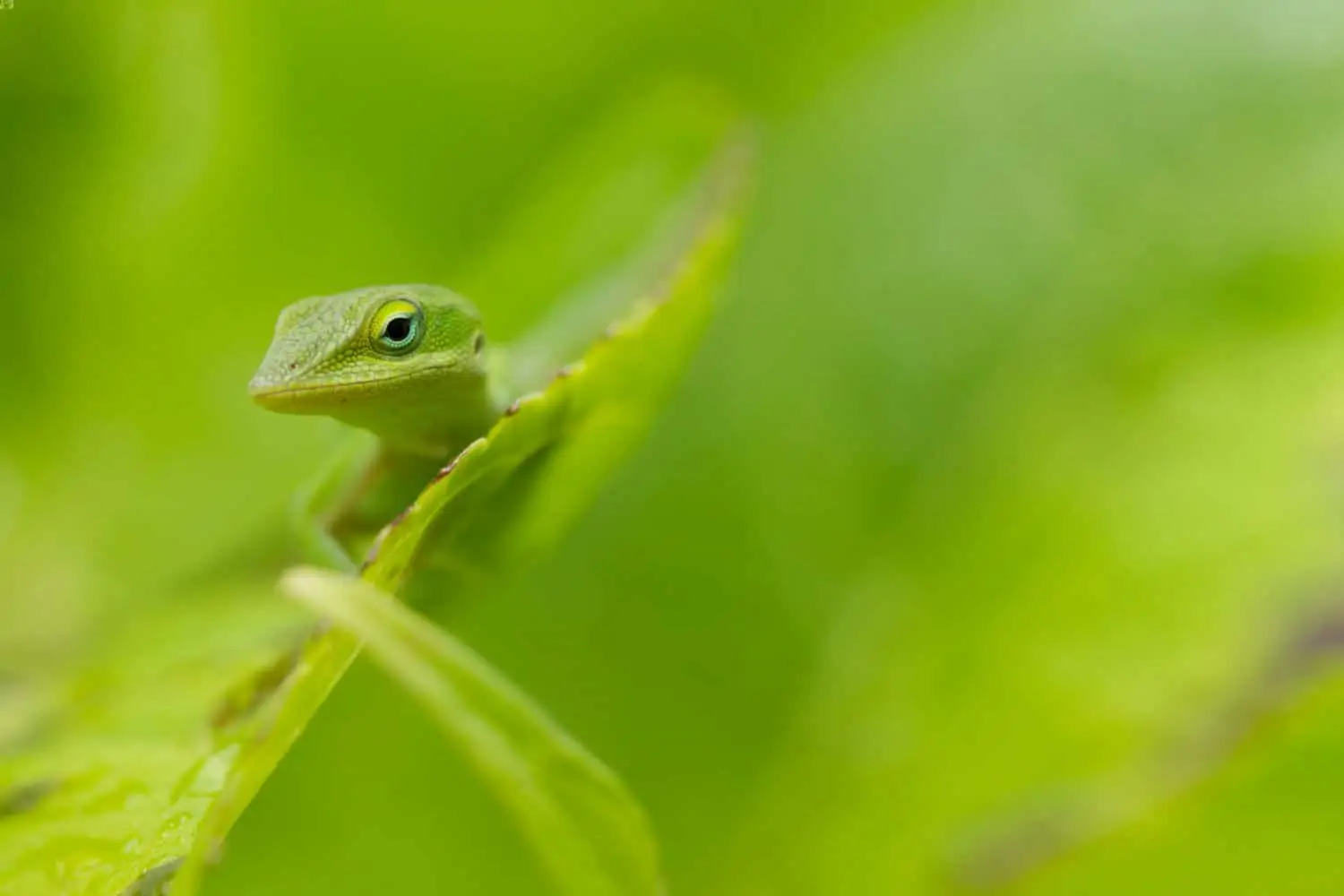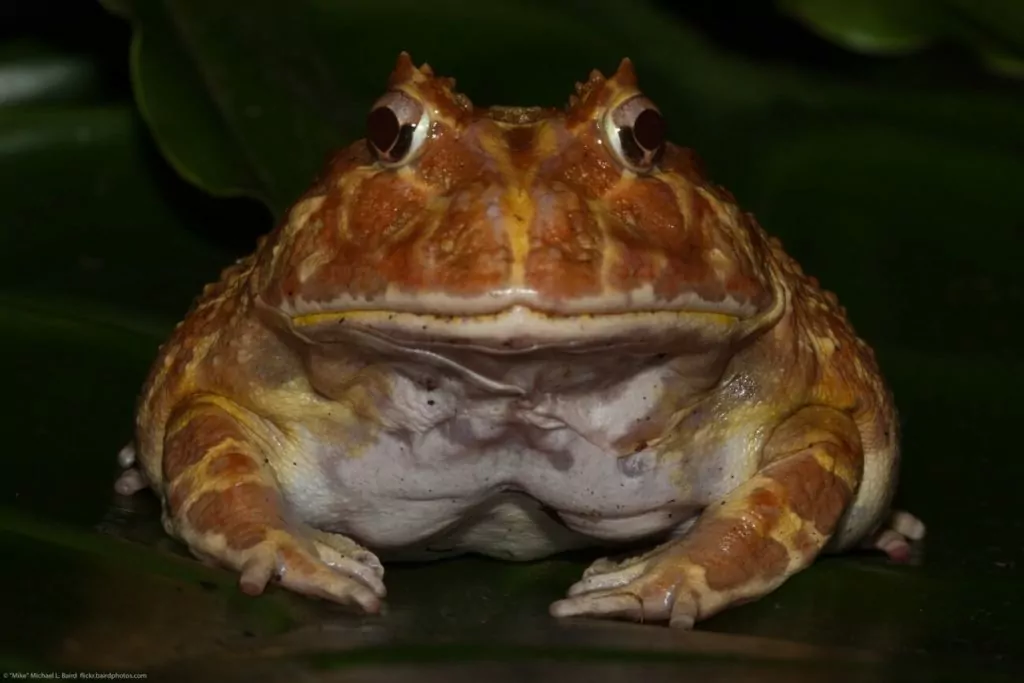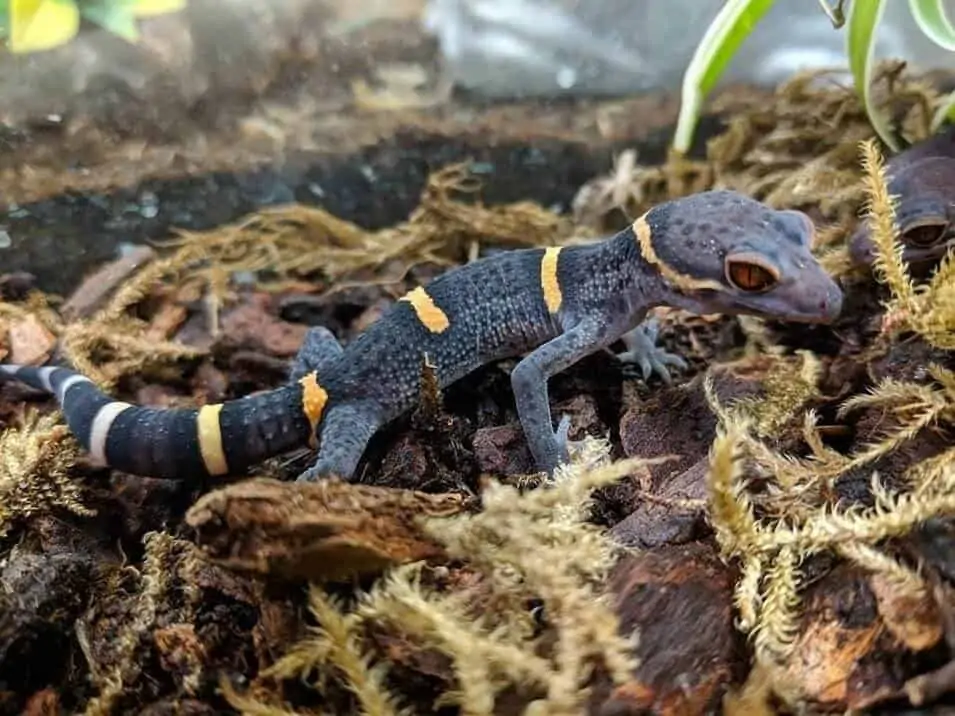Green anoles are a wonderful pet reptile that we highly recommend. They’re great for beginners or any owner who wants a low-maintenance lizard to keep!
But even though this species doesn’t require a lot of effort, there are still some important care requirements you should know if you want them to thrive.
This guide dives into all the essentials of green anole care. You’ll learn about their diet, lifespan, habitat setup, tank size, and many other useful facts!
Table of Contents
Species Summary
The green anole (scientific name: Anolis carolinensis) is a species of reptile found in areas of Tennessee, Texas, Florida, Georgia, Louisiana and the Carolinas. In fact, it’s the only kind of anole that is native to the United States.
It’s known in the reptile world as a fairly easy going type of pet lizard that makes a good starter pet (they’re commonly used as “class pets” in elementary schools). Even though the green anole doesn’t need a fancy set up or require a highly specialized diet, you are still going to have to give it lots of care and attention.
Appearance & Colors
Part of the green anole’s charm is its simple beauty and ability to change colors according to its mood and situation.
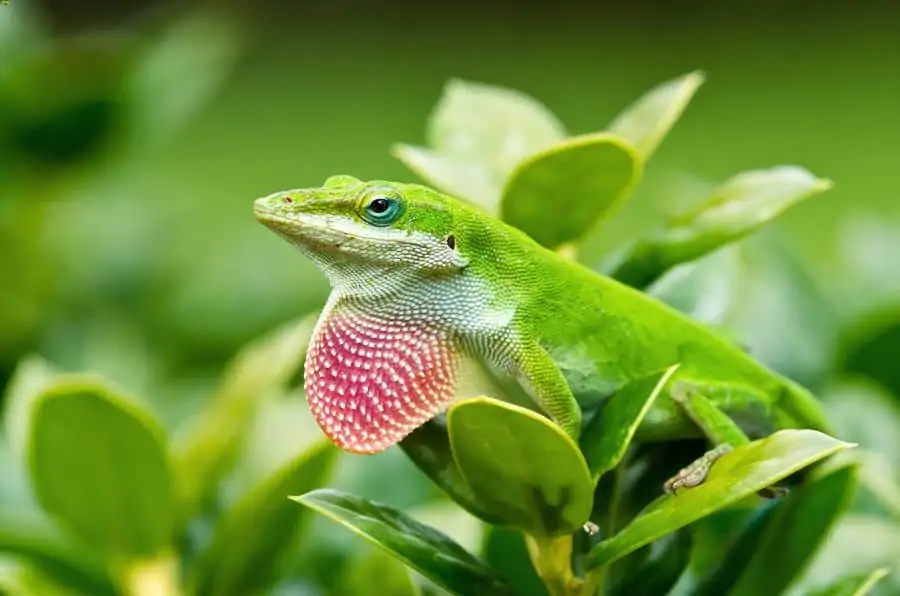
When your anole is a lovely, vivid green, it means that it is happy, active and warm. When it is sleeping or too cold, it will change its color to brown. A dark brown color can be an indication of illness or stress.
Other characteristics include a pink dewlap, large eye sockets and a triangular-shaped head. Males tend to have heavier bodies and larger dewlaps, which is fairly normal when it comes to these kinds of visual displays.
Green Anole Lifespan
The average green anole lifespan is around four years in captivity. In some situations these pet reptiles have lived as long as eight years, but that’s quite uncommon.
Expert Tip: The two main factors that can impact the lifespan of a green anole are genetics and quality of care. You can increase your chance of getting lucky when it comes to genetics by purchasing your pet from a reputable seller.
When it comes to providing great care, all you need to do is follow the recommendations in this guide!
Average Size
The typical size of a male green anole is about eight inches, and a female green anole is slightly smaller at around five to six inches in length. Hatchlings are around an inch long.
This length includes the tail which makes up half of the green anole’s total length. This is important to know because it paints a more accurate picture of their true size. These lizards really aren’t that large!
Green Anole Care
Green anole care is quite simple, which is why this species is such a commonly recommended pet reptile for beginners. However, they still have some very specific care requirements that you’ll need to know if you want them to thrive.
These smart lizards are active climbers, so you’ll need to give them plenty of things on which to climb. Some other requirements (which will be discussed in detail later) include gradient heating, special lighting, a basking area, a healthy diet and a commitment to their daily care and needs.
Read the following sections to learn all the basics of green anole care.
Tank Size
Green anoles really don’t need anything complicated when it comes to their living space. A small terrarium or reptile tank will do fine.
In terms of tank size, a ten gallon vertical tank can comfortably house one or two green anoles. However, if you have the space for a larger enclosure that’s even better.
Expert Tip: One important thing to know about green anoles is that they’re most comfortable in high areas like shelves or bureaus. Placing their enclosure in a low spot makes them nervous and stressed.
Habitat Setup
Putting together a beautiful and safe habitat setup for your green anole can be lots of fun. As long as you understand the basic requirements of these pets, you can let your creative juices flow!
The first thing you’ll want to add to the terrarium is some kind of substrate. This should be something that will stay damp after misting but won’t get too wet. Peat moss and soil work well as does orchid bark. Never use an oily substrate such as pine shavings.
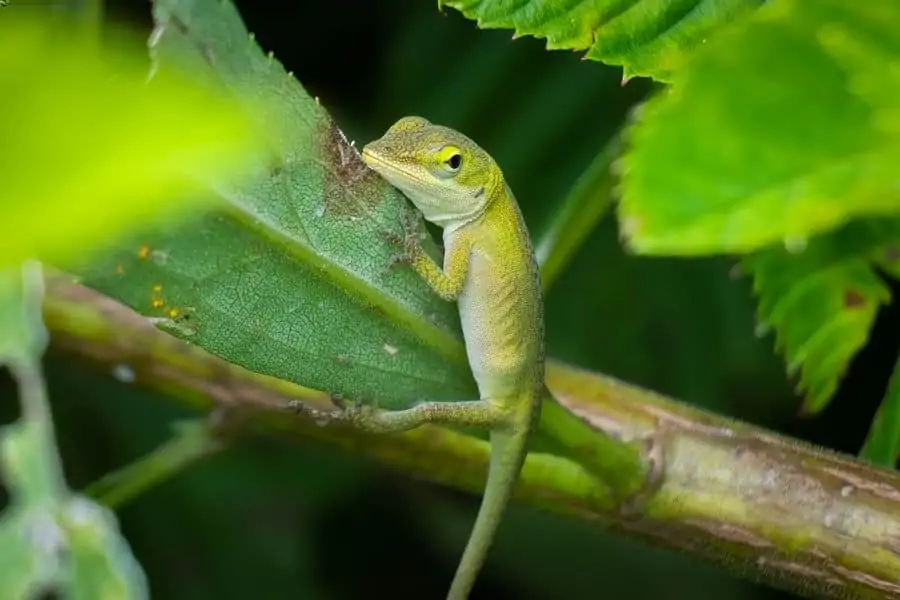
Basking is important for temperature regulation and food digestion, so you will want to create a nice basking area. Pieces of bark or branches are appropriate. An added benefit of using branches is that they also provide things to climb.
Your green anole is going to need lots of places to hide, and they love to hide in vegetation. With this in mind, planting things, like ivy, orchids, bromeliads or snake plants, will provide natural hiding spots and increased aesthetics.
Expert Tip: Green anoles are known for squeezing through small spaces, so you are going to need to make sure you have a tight-fitting cover for your enclosure.
Temperature & Lighting
When you’re designing the enclosure for your green anole, one of the most important aspects is going to be to create gradient heating.
This is just a fancy way of saying that your anole needs a warmer place to bask and get warm, and it needs a cooler area to just chill out and cool off. This is because reptiles, your green anole included, are not able to internally adjust their body temperatures.
Here are the temperatures to aim for in both of these areas:
- The ambient temperature for your anole’s environment needs to be between 75 and 80 degrees Fahrenheit
- The basking area you create should be between 85 and 90 degrees Fahrenheit
It’s perfectly safe to let the nighttime temperature drop to 65-75 degrees Fahrenheit.
We suggest placing the basking light on one side of the tank, and leaving a cooler area on the other side. Placing multiple thermometers around the tank will let you easily monitor the temperature in all the areas within the enclosure.
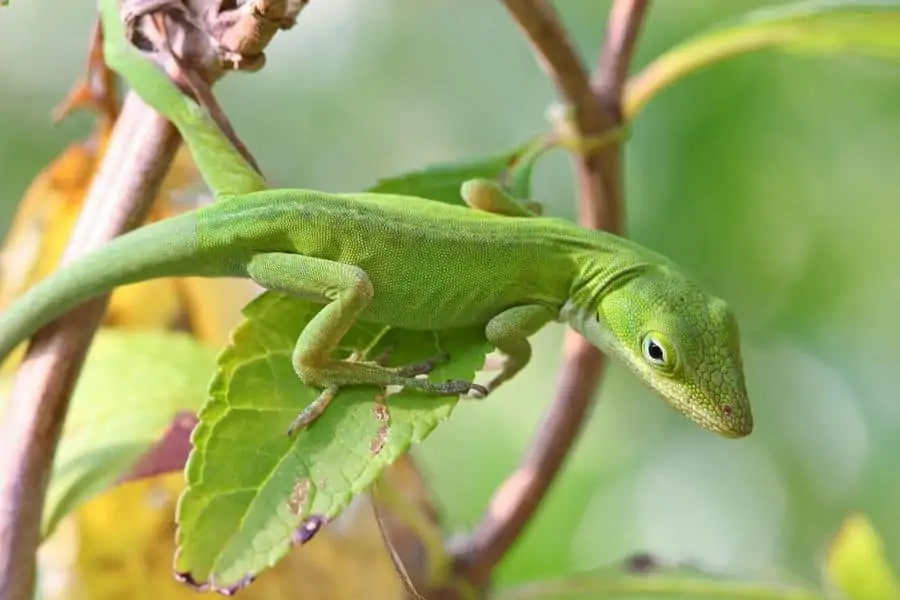
Some heating options that we recommend are under-the-tank heaters, heating pads and a ceramic light for the nighttime. Make sure to turn off the basking light at night. Your lighting should follow a 12 hours on, 12 hours off routine.
Green anoles need a good source of UVA/UVB light. This helps to prevent metabolic bone disease. Using a full-spectrum UVA/UVB bulb is highly recommended, and make sure to change the bulb every six months.
Humidity
Keeping the humidity level in your reptile tank at 60 to 70 percent is one of the most important parts of proper green anole care.
All you really need to do is mist the enclosure once or twice a day to achieve this. The key is to keep the enclosure damp, not wet. Increasing the amount of plants in the environment can really help with maintaining the right humidity level.
Expert Tip: We highly suggest using a reliable hygrometer to ensure that the correct humidity is maintained at all times. It’s money well-spent!
Water
Your green anole is not going to need any fancy or complicated watering device. It will get all the water it needs by drinking water droplets that form after you’ve misted the enclosure.
Because they can easily drown, putting any type of water bowl in your anole’s enclosure is highly discouraged.
Food & Diet
Green anoles are insectivores, so giving your pet lizard healthy, gut loaded insects is going to be the best way to provide them with good nutrition. Prey items of choice include crickets, mealworms, waxworms and farm-raised maggots.
Never give your green anole super worms or kingworms. These worms have sharp mandibles that can hurt these reptiles!
Some anole owners feed their pets wild-caught prey, but this is not really a good idea. Insects caught in the wild may contain pesticides or other toxins.
Rules for feeding your green anole include:
- Make sure the insect is no larger than half the size of your anole’s head
- Dust the insects with calcium and vitamin powder before you feed your anole
- Give your green anole two to three insects at a time.
- It’s best to feed them every other day
Potential Health Issues
Compared to many pet lizards, the green anole has relatively few health issues (another reason why they’re such great pets). Health problems that may crop up are ones that are usually environment-related. Let’s take a quick look at a few of the issues you may encounter.
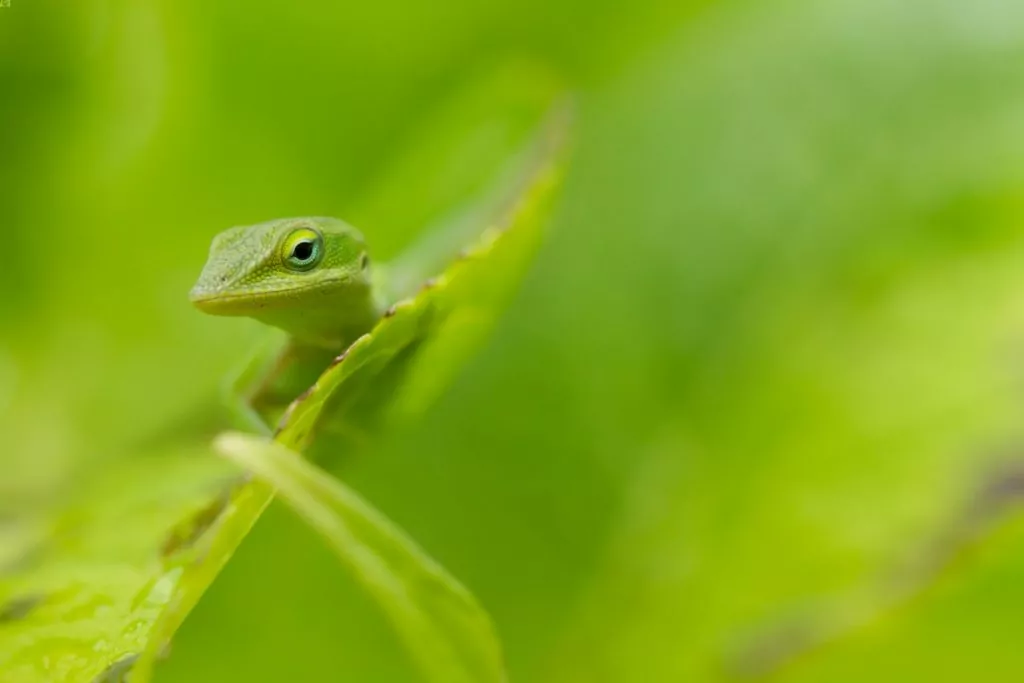
Respiratory infections: Like most lizards, green anoles are quite susceptible to respiratory infections. This can stem from conditions that are too cold and or too damp. Keeping tabs on the enclosure’s temperature and using an appropriate substrate can go a long way towards preventing respiratory illness.
Signs of a respiratory infection include discharge from the eyes and open-mouthed breathing. See a vet right away if you suspect respiratory issues.
MBD: Metabolic bone disease is something that reptile owners really need to watch out for. This issue comes from a lack of UVB light or a lack of proper nutrition. Metabolic bone disease is totally preventable with proper feeding habits and supplemental UVB lighting.
Symptoms to look out for include weak legs, lethargy or a puffy jawline.
Mouth rot: This can develop from cuts or abrasions in the mouth or snout area. If your green anole has puffiness around the mouth or a whitish build-up around the teeth, it could be mouth rot. Take your anole to the veterinarian right away for treatment.
Stress: Improper handling or even too much handling can stress out your green anole. Stress can cause your pet to become more susceptible to infections and other health problems.
Burns: These can occur if the basking light is too close to the basking area. Always make sure that the basking temperature does not go above 90 degrees Fahrenheit.
Behavior & Temperament
If you’re looking for a pet lizard with a nice, friendly temperament, then a green anole is a great choice. This is why it’s often the lizard of choice for kids or for novice lizard owners.
The green anole is diurnal, (most active during the day), and you’ll see it climbing, exploring and basking. They also love to hide, which is why having lots of plants in your enclosure is a great idea.
Overall, these lizards are fun to spectate and observe throughout the day.
Handling Tips
The green anole is a pretty friendly reptile that will tolerate a little bit of handling. With patience and time, these lizards may even trust you enough to sit on your shoulder or eat from your hand!
Expert Tip: We don’t recommend handling a new green anole for several weeks. These anoles can suffer from stress, so it’s best to let them settle in and get used to you.
Because the green anole is quite fragile, knowing how to pick it up safely is very important. Never pick your green anole up by its tail. Their tails can break off very easily, so always pick it up gently by the belly.
If you have kids who are going to be handling the anole, they should not be allowed to handle it without constant adult supervision. And remember, keep the handling to an absolute minimum!
Conclusion
Green anole care is about as low-maintenance as it gets. These fantastic reptiles make amazing pets, and are perfect for any owner who wants to avoid hassle.
Even though they’re quite popular and sometimes considered a “starter reptile” we recommend them to anyone. There’s nothing wrong with your pet lizard not requiring a lot of attention! When you combine this with their fairly high activity level, this makes them quite a fun pet to own.
Feel free to recommend additional information or facts that we should add to this care sheet. We love getting suggestions from our readers!

